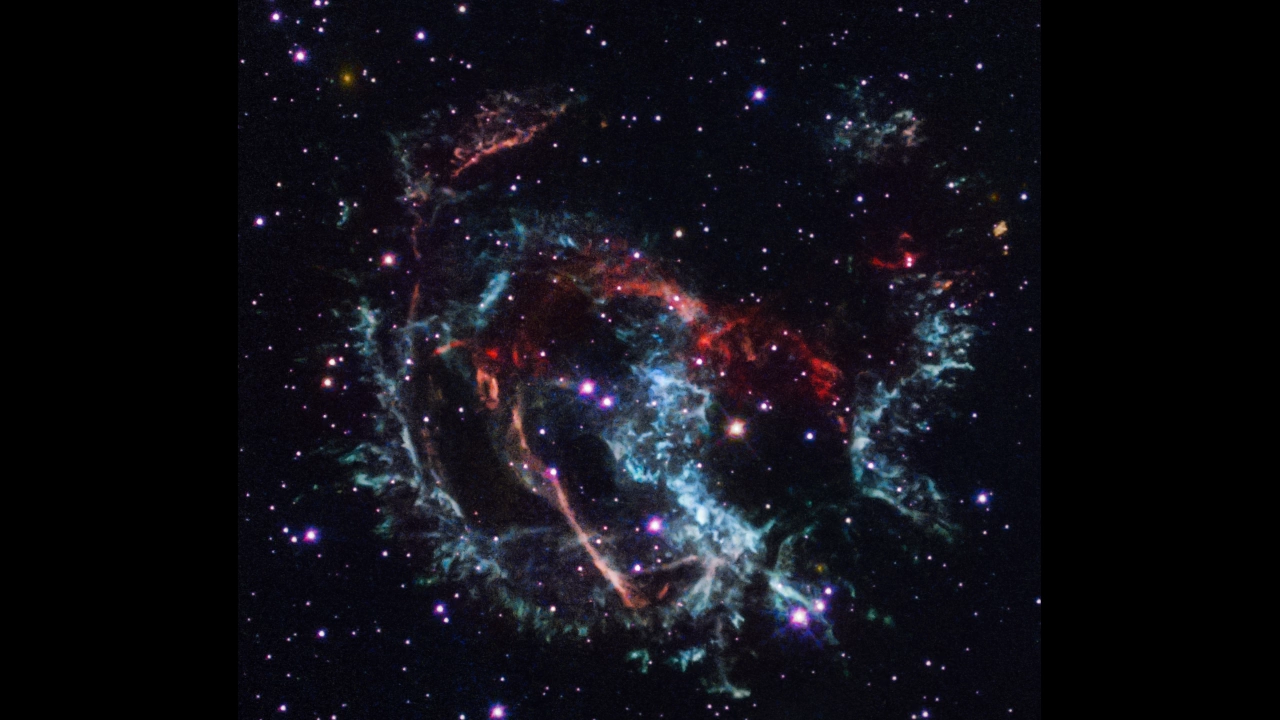1 min read
Supernova Remnant 1E 0102 Compass

About the Object
- R.A. PositionR.A. PositionRight ascension – analogous to longitude – is one component of an object's position.01:04:01.2
- Dec. PositionDec. PositionDeclination – analogous to latitude – is one component of an object's position.-72:01:52
- ConstellationConstellationOne of 88 recognized regions of the celestial sphere in which the object appears.Tucana
- DistanceDistanceThe physical distance from Earth to the astronomical object. Distances within our solar system are usually measured in Astronomical Units (AU). Distances between stars are usually measured in light-years. Interstellar distances can also be measured in parsecs.Roughly 200,000 light-years
- DimensionsDimensionsThe physical size of the object or the apparent angle it subtends on the sky.Image is approximately 1.4 arcminutes across (84 light-years)
About the Data
- Data DescriptionData DescriptionProposal: A description of the observations, their scientific justification, and the links to the data available in the science archive.
Science Team: The astronomers who planned the observations and analyzed the data. "PI" refers to the Principal Investigator.The HST observations include those from program 13378 (D. Milisavljevic)
- InstrumentInstrumentThe science instrument used to produce the data.WFC3/UVIS
- Exposure DatesExposure DatesThe date(s) that the telescope made its observations and the total exposure time.13-14 May 2014
- FiltersFiltersThe camera filters that were used in the science observations.F467M; FQ492N; F502N; F657N; F665N; FQ508N; F673N
- Object NameObject NameA name or catalog number that astronomers use to identify an astronomical object.SNR 1E 0102.2-7219
- Object DescriptionObject DescriptionThe type of astronomical object.Supernova remnant
- Release DateJanuary 14, 2021
- Science ReleaseResearchers Rewind the Clock to Calculate Age and Site of Supernova Blast
- CreditNASA, ESA, STScI, John Banovetz (Purdue University), Danny Milisavljevic (Purdue University)

These images are a composite of separate exposures acquired by the WFC3/UVIS instrument on the Hubble Space Telescope. Several filters were used to sample narrow wavelength ranges. The color results from assigning different hues (colors) to each monochromatic (grayscale) image associated with an individual filter. In this case, the assigned colors are: Blue: F467M+FQ492N Green: F502N+F657N Yellow: F665N Red: FQ508N; F673N
Related Images & Videos

Supernova Remnant 1E 0102
Gaseous Relic of Titanic Explosion This Hubble Space Telescope portrait reveals the gaseous remains of an exploded massive star that erupted approximately 1,700 years ago. The stellar corpse, a supernova remnant named 1E 0102.2-7219, met its demise in the Small Magellanic Cloud,...

Supernova Remnant 1E 0102 Annotated
Hubble Portrait of Expanding Supernova Remnant Shows Path of Speedy Ejecta This Hubble Space Telescope image outlines the direction of high-speed ejecta flung from a titanic supernova blast approximately 1,700 years ago. The stellar corpse, a supernova remnant named 1E...

SNR 1E 0102 Expansion
Hubble Time-Lapse Video Reveals Supernova Remnant Expansion This time-lapse video shows the movement of a supernova remnant—the gaseous remains of an exploded star—that erupted approximately 1,700 years ago. The stellar corpse, a supernova remnant named 1E 0102.2-7219, met its...
Share
Details
Claire Andreoli
NASA’s Goddard Space Flight Center
Greenbelt, Maryland
claire.andreoli@nasa.gov































